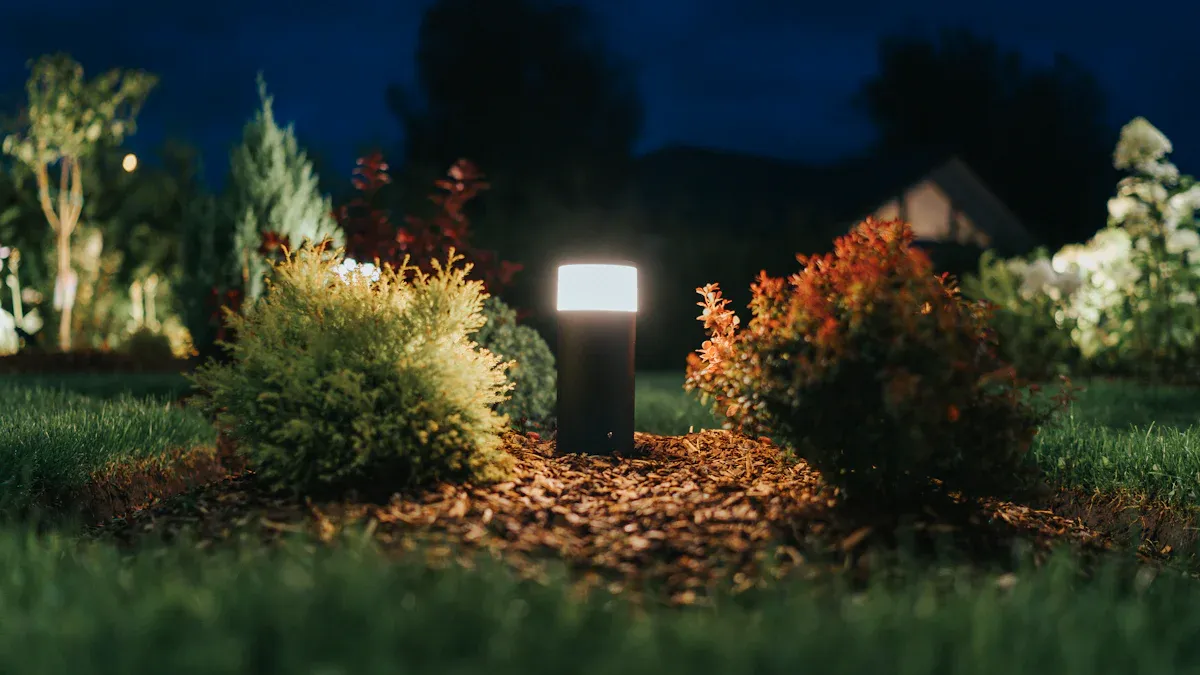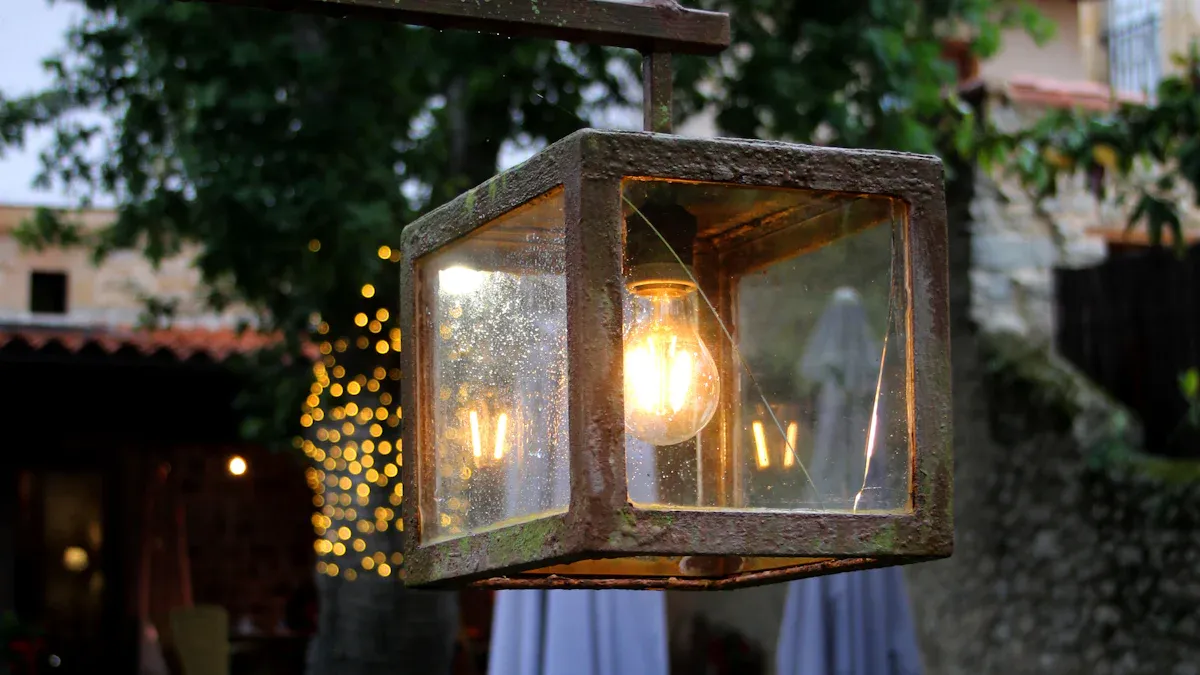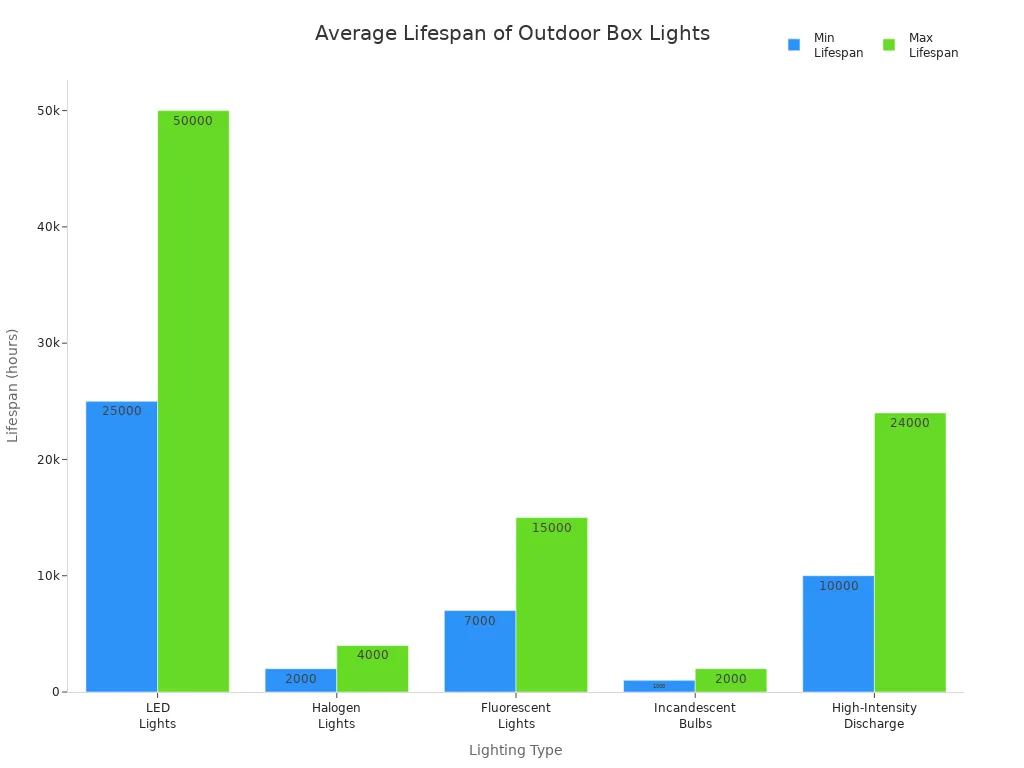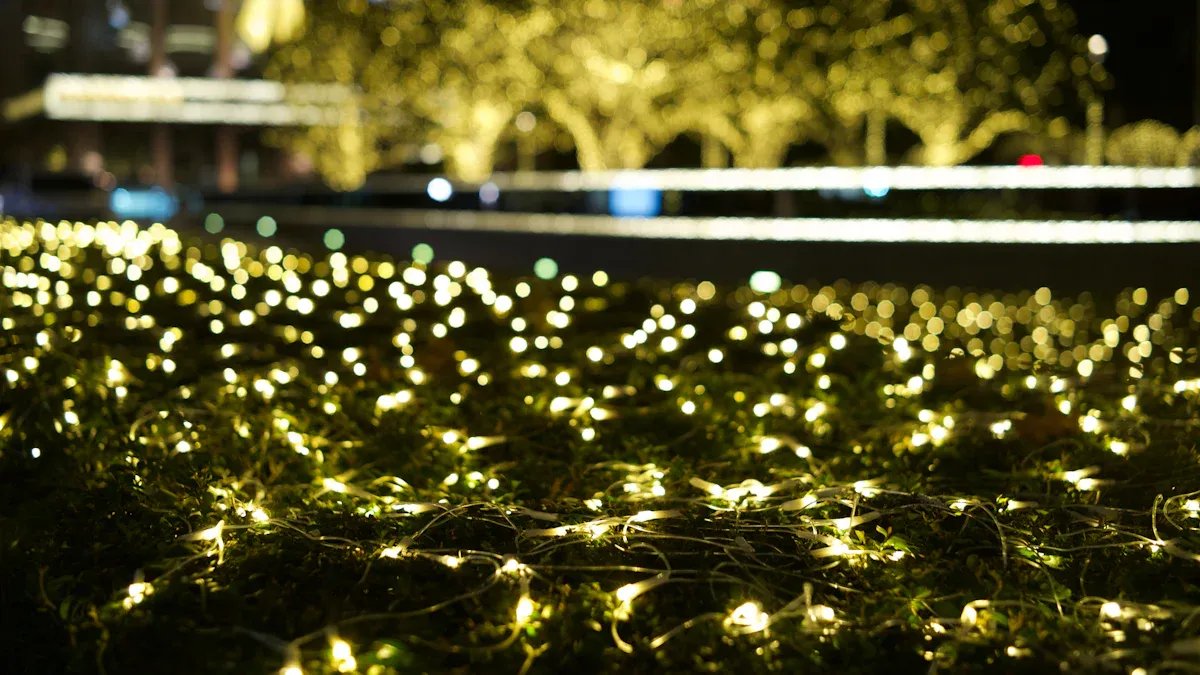How to Choose the Right Outdoor Box Light for Your Property: Materials, Sizes, and Illumination Options

You want to choose the right outdoor box light. There are many choices, and it can feel hard. Think about your home and the weather. Do you worry about rain, snow, or strong sun hurting your lights? The best lights use strong materials. They come in the right size for your space. They also give the right amount of light. Always check if the lights are waterproof. Make sure they can handle bad weather. Pick lights that are easy to put up. Many people forget to plan. Some ignore local rules or pick the wrong bulbs. This can cause problems. Your property needs lights that look good and keep it safe.
Mistake | Description |
|---|---|
Inadequate Planning | Not making a good lighting plan can cause lights in bad spots and safety risks. |
Neglecting Local Codes | Not following local rules can mean fines and unsafe lights. |
Improper Wiring Techniques | Bad wiring can cause short circuits and fires. |
Ignoring Energy Efficiency | Picking old bulbs instead of energy-saving ones can cost more money. |
Key Takeaways
Pick outdoor box lights made with strong materials like aluminum or stainless steel. These materials can stand up to bad weather and last a long time.
Always look at the waterproof rating on your lights. Ratings of IP65 or higher mean the lights can handle rain and snow.
Measure your area before you buy lights. The right size helps your outdoor space look nice and balanced.
Choose the right bulb type for outside. LED bulbs save energy and last longer than other bulbs.
Think about your lighting plan before you start. Use safety lights, ambient lights, and accent lights together. This makes your space safer and more beautiful.
Choose the Right Outdoor Box Light: Key Factors
When you want to choose the right outdoor box light, you need to think about a few main things. The type of fixture, how it fits with your space, and how easy it is to install all matter. You also want to make sure your lights can handle rain, snow, or even a splash from the garden hose. Picking a fixture with a high waterproof rating, like IP65 or higher, keeps your outdoor lighting safe and working for a long time.
Types of Outdoor Box Lights
You have many choices when it comes to outdoor box lights. Each type has its own features and works best in different spots. Here’s a quick look at some popular types:
Type | Features |
|---|---|
Illuminated Signage | Uses LED lights for bright, even lighting. Great for showing off business names or logos. |
Decorative Light Boxes | Adds style and mood with cool designs and light effects. Perfect for making your yard look special. |
Wayfinding Light Boxes | Helps people find their way. These are bigger and often show maps or arrows for navigation. |
You can also pick from different mounting styles. Some fixtures attach to walls, others hang from ceilings, and some stand alone on posts. Here’s how each one works:
Wall-mounted lights: You put these on walls. They work well by doors, patios, or garages.
Ceiling or hanging lights: You hang these from above. They fit best under covered porches or decks.
Post-mounted lights: These stand on their own. They light up driveways, walkways, or gardens away from your house.
When you plan your lighting design, think about what you want the light to do. Do you need to light up a path, show off a cool tree, or just make your backyard feel cozy? The size of your yard and where you want the light will help you pick the right fixture.
Tip: If you have a big yard or lots of tall trees, you might need taller fixtures or ones that shine farther. For small patios, lower or wall-mounted lights often work best.
Fixture Compatibility and Installation
You want your outdoor lighting to work well and last a long time. That means picking a fixture that matches your space and is easy to install. Always check if the fixture is made for outdoor use. Look for a waterproof rating of at least IP65. If you live where it rains a lot, go for IP66 or IP67. These ratings mean your fixture can handle heavy rain or even a quick dunk in water.
When you choose the right outdoor box light, make sure it fits with your home’s style and your needs. Some people like safety lighting, like motion-sensor path lights, to keep walkways safe. Others want ambient lighting, such as hanging lights or rope lights, to make their space feel warm and inviting. You might also want task lighting for cooking outside or accent lighting to show off your favorite plants.
Here are some things to check before you install a new fixture:
Make sure the fixture fits the spot where you want to put it.
Check that the wiring matches your home’s setup.
Pick a fixture that is easy to mount and take down if you need to change bulbs.
Think about how the fixture will look with your other outdoor lighting.
Many people replace old fixtures because they stop working, get damaged by weather, or the bulbs burn out. If you pick a strong, weatherproof fixture, you will not have to replace it as often.
Note: Good lighting design uses the right mix of fixtures. You can combine safety, ambient, and accent lights to make your yard both safe and beautiful.
Materials and Durability

Common Materials
When you pick an outdoor box light, the material is very important. The right material helps your fixture look nice and work well for a long time. Here’s a simple chart that shows how some popular materials compare:
Material | Durability | Resistance |
|---|---|---|
Aluminum | Corrosion resistant, lightweight | Ideal for outdoor applications |
Stainless Steel | Unmatched durability, wear and tear resistant | Best for harsh environments |
Plastic | Lower durability, can crack or fade | Less effective for long-term outdoor use |
Aluminum is a good choice if you want something light and easy to put up. Stainless steel is strong and keeps looking shiny, even in bad weather. Plastic costs less, but it might break or fade if it gets too much sun or cold. Bronze is also a strong choice. It does not rust and makes a layer that protects it over time.
Tip: If you want a fixture that is easy to care for, pick bronze or aluminum. These materials do not rust and can handle bad weather, so you do not have to fix them much.
Weather Resistance
Outdoor lights get hit by rain, snow, and sun all the time. You need a fixture that can handle these things. Look for weather-sealing and a high IP rating. A fixture with IP65 or higher keeps out water and dust. Sealed joints and screws that do not rust help your fixture last longer.
Here are some easy ways to keep your fixture working well:
Pick a fixture with a high IP rating.
Seal all the joints and use screws that do not rust.
Check the seals often to keep water out.
Bronze fixtures do great in places where the weather changes a lot. They make a layer that stops rust. Aluminum and stainless steel also do not rust, but sometimes need a special coat for extra safety. Plastic fixtures can block UV rays but may break or fade after a while.
How much care your fixture needs depends on the material:
Bronze and aluminum need less care.
Plastic may need to be replaced more often.
Metal might need new paint sometimes.
Glass looks nice but needs to be cleaned often.
The bulb you use also matters for how long your fixture lasts. LED lights can last up to 50,000 hours. Incandescent bulbs do not last as long and burn out faster.

Pick the right material and your fixture will last through bad weather and keep your property bright and safe.
Size and Placement
Measuring Your Space
Getting the right size for your outdoor box light starts with measuring your space. You want your lights to fit perfectly, not look too small or too big. Grab a tape measure for short areas like patios or fences. For longer runs, you can use Google Maps to estimate distances. If you need to measure something high up, like a roofline or a tall tree, a laser distance tool or Google Earth makes the job easier and safer.
Here’s a quick table to help you figure out the best way to measure different surfaces:
Surface Type | Why It’s Tricky | How To Measure It Right |
|---|---|---|
Rooflines & Edges | Hard to reach, lots of angles | Use Google Earth or a laser tool for verticals |
Columns & Posts | Spirals and wraps change footage | Measure height and circumference, estimate wrap spacing |
Trees | Lots of branches, odd shapes | Measure trunk and branches, multiply by count |
Stairs | Different lighting needs | Measure width or height × number of steps |
Lawns & Fences | Curves and corners add length | Lay out a string or hose, then measure |
Commercial Façades | Many sections and drops | Break into rectangles, add connectors for corners |
You can also use a simple list of tools:
Tape measure for short, ground-level spots
Google Maps for long, straight runs
Google Earth for tricky, multi-level areas
Laser distance tool for hard-to-reach places
Tip: Always double-check your measurements before you buy your lights. This saves you time and money.
Proportional Sizing
Picking the right size for your outdoor box light makes your space look balanced and bright. If your light is too small, it gets lost. If it’s too big, it can look out of place. You want your lights to match the size of your doors, garage, patio, or pathway.
Here are some easy sizing rules:
For your front entrance, choose wall lights that are about one-third to one-fourth the height of your door. Place them six inches from the door frame and sixty-six inches from the ground.
On a single garage door, center your light six inches above the trim. For double garages, put lights on both sides.
Over a patio table, pick a chandelier that’s two-thirds the width of the table. Hang it thirty to thirty-four inches above the tabletop.
For pathways, use lights that stand fourteen inches tall. Stagger them for even lighting.
If you follow these simple sizing tips, your outdoor box lights will look great and give you the light you need. You’ll make your property safer and more welcoming, too.
Illumination Options

Brightness Levels
You want your outdoor lighting to feel just right. If you use too much light, you get harsh shadows and it’s hard to see. If you use too little, you might trip or miss a step. For pathways, you should look for box lights that give off 100 to 200 lumens. Decks and patios need a bit more, around 100 to 300 lumens. When you set up landscape lighting, think about how each area will be used. Sitting areas on patios work best with about 6 foot-candles. Dining spaces need around 15 foot-candles. Well-planned lighting design makes your yard safer and more welcoming.
Good outdoor lighting helps you see clearly and keeps your property secure. If you plan your landscape lighting carefully, you can avoid accidents and make your space feel cozy.
Bulb Types
Choosing the right bulb for your outdoor box light matters. LED bulbs work best for outdoor lighting. They last a long time, use less energy, and handle rain or extreme temperatures. CFL bulbs save energy but don’t last as long as LEDs. Incandescent bulbs use the most energy and burn out quickly. You should look for bulbs labeled “wet rated” or “damp rated” for landscape lighting. These bulbs work safely in moisture and tough weather. If you see a UL mark, you know the bulb meets safety standards.
Bulb Type | Energy Efficiency Rating |
|---|---|
LED | |
CFL | More efficient than incandescent |
Incandescent | Least energy-efficient |
LED bulbs are perfect for landscape lighting because they keep your energy bills low and work well in all seasons.
Color Temperature
Color temperature changes how your outdoor lighting feels. Warm lighting (2000K-3000K) makes your patio or garden feel cozy. Neutral lighting (3000K-4000K) gives you clear light for relaxing or working outside. Cool lighting (4600K-6500K) is best for security. It looks like daylight and helps you spot anything unusual. For landscape lighting, use warm colors for dining or sitting areas. Use cool white for security lights near gates or driveways.
Warm colors (2000K-3000K): Great for relaxing and dining.
Neutral colors (3100K-4500K): Good for general landscape lighting.
Cool colors (4600K-6500K): Best for security and safety.
If you mix different color temperatures in your lighting design, you can create a space that feels safe and looks beautiful.
When you choose the right outdoor box light, you make your outdoor lighting safer and more stylish. Start by checking your illumination needs, weather conditions, and installation process. Use this table to help:
Step | What to Do |
|---|---|
Assess Needs | Count fixtures and power needed |
Check Weather | Pick waterproof, weatherproof lights |
Plan Installation | Make sure it’s easy and safe |
Outdoor lighting with high waterproof ratings lasts longer and keeps your property secure. If you follow these tips, you’ll enjoy a brighter, safer yard every night. Ready to upgrade? Pick the best lights for your space today!
FAQ
What does IP65 mean for outdoor lights?
IP65 means your light keeps out dust and water. You can use it outside in rain or snow. You do not need to worry about splashes from your garden hose.
How do I know what size box light to buy?
Measure your space first. Pick a light that fits well and looks balanced. For doors, choose a fixture about one-third the height of the door.
Can I use regular bulbs in outdoor box lights?
You should use bulbs marked “wet rated” or “damp rated.” Regular bulbs may not last outside. LED bulbs work best for outdoor use.
How often do I need to clean outdoor box lights?
Clean your lights every few months. Wipe off dirt and bugs. Use a soft cloth and mild soap. This keeps your lights bright and looking new.
Do outdoor box lights help with security?
Yes! Bright outdoor lights make it harder for people to hide. Motion-sensor lights can scare off trespassers. You keep your property safer with good lighting.
See Also
Exploring Outdoor Display Boxes: Varieties, Uses, and Choosing Tips
Understanding Acrylic Light Boxes: Uses, Advantages, and Choosing Advice
Tailored Acrylic Light Boxes: Design Choices, Materials, and Setup
Selecting the Ideal Acrylic Material for Light Box Signage
Durable Weatherproof Outdoor Display Boxes: Protection, Ratings, and Standards

